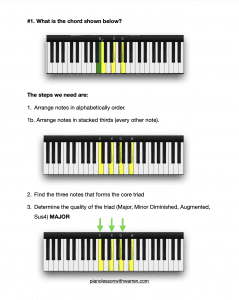The Most Effective Way To Master 2-5-1 Progressions Using The Cycle of 4th / 5th
In today’s lesson, we will cover the cycle of 4ths and 5ths and their appearance within the 2-5-1 chord progression, whilst learning some exercises to help you get to grips with the concept and technique.
This is a critical topic because, and I think it’s safe to say this, you will not understand how chords and harmony truly work until you master the cycle of 4ths and 5ths. Western music is built on tension and release, which can be heard within the 2-5-1 chord progression. Whenever advanced players use techniques such as substitution and reharmonization, you usually hear the 2-5-1 progression, which is derived from the cycle of 4ths and 5ths.
Before I explain the reasons people refer to this concept as the cycle of 4th or the cycle of 5th, please note that if you haven’t learned intervals yet, you should probably go ahead and check out our other content on that topic as it’s crucial to understand the concepts we’re covering today.
What is the Cycle of 4ths / Cycle of 5ths?
To demonstrate the cycle of 4ths / 5ths, I’ll be using practical examples you can follow on your own instrument.
Example 1: Understanding the Cycle of 4ths / 5ths
First, play a perfect 4th interval formed of five half-step movements. You can do this by playing the notes C and F. Second, invert the interval, placing the right-hand note on the left side instead. In our example of C and F, this inverted perfect 4th interval would become F and C. This new interval is a perfect 5th, formed of 7 half-steps, thus inspiring the cycles of 4th and 5th.
Example 2: The Relationship between the Cycle of 4ths & 5ths
The cycle of 4ths and 5ths is called a ‘cycle’ for more than one reason:
First, play all the notes from the cycle of 4th in ascending order, moving perfect 4ths upwards from C (C – F – Bb – Eb – Ab – Db – Gb – B – E -A – D – G – C). Next, invert this scale by playing these notes in the same order but descending from right to left on the keyboard. This will transform those same notes into perfect 5th intervals. The notes and their order remain identical, but the direction of the notes is different, changing the intervals and widening them from 4ths to 5ths. The cycle and 4ths and 5ths are closely linked but depend on the direction in which you’re going.
The Cycle of 4ths and The 2-5-1 Progression
In this lesson, I’ll be focusing on the cycle of 4th. This is because we often think of left to right when we think about the progression movement. This can be demonstrated through the familiar chord progression: Dm7 – G13 – Cmaj9, where I’m using the 2-5-1 progression (D = 2, G = 5, C = 1), with each chord movement formed of a perfect 4th interval.
The Cycle
As mentioned above, if you start with the note C, the cycle of 4th plays the following scale: C – F – Bb – Eb – Ab – Db – Gb – B – E – A – D – G – C. This scale hosts every note of the chromatic scale within it, traveling through each tone of the piano until it winds back to C again, where it can restart its cycle. This is another reason why the cycle of 4ths is called a ‘cycle,’ as it always returns to its beginning.
This cyclical effect can be demonstrated using chords as well as notes, such as in the following 2-5-1 progression, which takes its chords from the cycle of 4ths: Cm – F – Bb – Bbm7 – Eb – Ab – Abm – Db7 – Gb – Gbm – B7 – E – Em – A – D – Dm – G – C.
Putting Theory into Practice
Once you know that a 4th is comprised of five half-steps, and you know how to pick out all the notes from the cycle of 4th, it’s time to start practicing that harmonically so you can go through those changes quickly. The faster you can go through the cycle of 4th using chords, the easier it will be for you to learn, reharmonize and substitute songs.
The cycle of 4ths Exercise
For this exercise, it doesn’t matter what key you’re in – right now, we’re just trying to understand the pattern. This is because when you’re playing, the pattern often stands out and sticks with you the most. We don’t usually have time to calculate the keys on the spot, so this practice exercise teaches an alternative.
Let’s take a C major chord (formed of the notes: C – E – G). Then, make it a C minor (C – Eb – G), then go to F (F – A – C), and lastly to Bb (Bb – D – F). This simple chord progression holds the 2-5-1 progression within it, the 2 chord being C minor, the 5 chord being F major, and the 1 chord being Bb major. Also, the intervals between C – F and F – Bb are perfect 4ths.
Now, we can take that last chord we landed on, the Bb major chord, and turn it into a minor (Bbm; Bb – Db – F). Then, we can move upwards by a perfect 4th interval to Eb major (Eb – Bb – G) before going up another perfect 4th to Ab major (Ab – C – Eb). Again, this is a 2-5-1 progression.
Next, change the landing Ab major into an Ab minor (Ab – B – Eb; the 2 chord), then ascend a perfect 4th to Db major (Db – F – Ab; the 5 chord), and then move up another perfect 4th to Gb major (Gb – Bb – Db; the 1 chord).
We’re in Gb now, so again, we can make Gb a minor chord (G – A – Db; 2), go to the perfect 4th (B major (B – Eb – Gb; 5) and to the next perfect 4th chord, E major (E – Ab – B; 1).
From E major, we can change it into an Em chord (2) and follow the pattern to A major (5) and to D major (1).
Again, continue the pattern by changing your landing chord, D major into a D minor (2), ascending a perfect 4th to G major (5), and ascending another perfect 4th to C major.
Lastly, if I play C minor next, the cycle starts again.
The cycle of 4ths/2-5-1 Exercise – A Simple Formula
Start with the note/chord C, and change it into a minor (chord 2)
Raise it a perfect 4th (chord 5)
Raise it another perfect 4th (chord 1)
Make your landing chord (1) your new starting place by changing it into a minor (2)
Raise it a perfect 4th (5)
Raise it another perfect 4th (1)
Repeat
Tips for Completing the Exercise
I recommend you practice your cycles of 4th in this way, cycling through the scale till you return naturally to C major.
To make things interesting so that you can play each chord out of the 12 tones as both a minor and as a major, you can try starting on C# rather than C and practice the same pattern from there. This is one of the most powerful exercises I’ve encountered when practicing 2-5-1 progressions.
Another important thing to note is to play your chord voicings in the closed position. I wouldn’t suggest playing everything in the root position because, realistically, we don’t play like that; we play using smooth voice leadings and closed positions. If you’re new to this, it might take some time to get used to this concept, but you’ll want to go right ahead and start developing your understanding of progressions in this way so later on, you won’t be stuck with seeing your chords in root position. Of course, if you’re just getting started on this technique, it might take a while to get used to, but after weeks or years of practice, it will become effortless.
Tips for Beginners
If you find it challenging to go through that entire cycle without getting lost, try breaking it up into sequences, as indicated by the paragraph breaks. Try taking the first two sequences (Cm – F – B and Bm – Eb – Ab) and practicing them by themselves before slowly adding the following sequence (Abm – Db – Gb) onto the end of it, and then the next, until you’re able to piece together the whole progression fluently.
Tips for Intermediate and Advanced Players
More intermediate and advanced players can also try playing the cycle of 4ths progression using seven chords and other extensions rather than simple triads, including improv between each chord to test and master your ability further. If you’re able to practice and learn this, you’ll become unstoppable, being able to take any song, reharmonize it and substitute chords easily.
Download The 7 Steps To Naming ANY Chord PDF For FREE
With this PDF, you NEVER HAVE TO GUESS what chord you’re playing.





